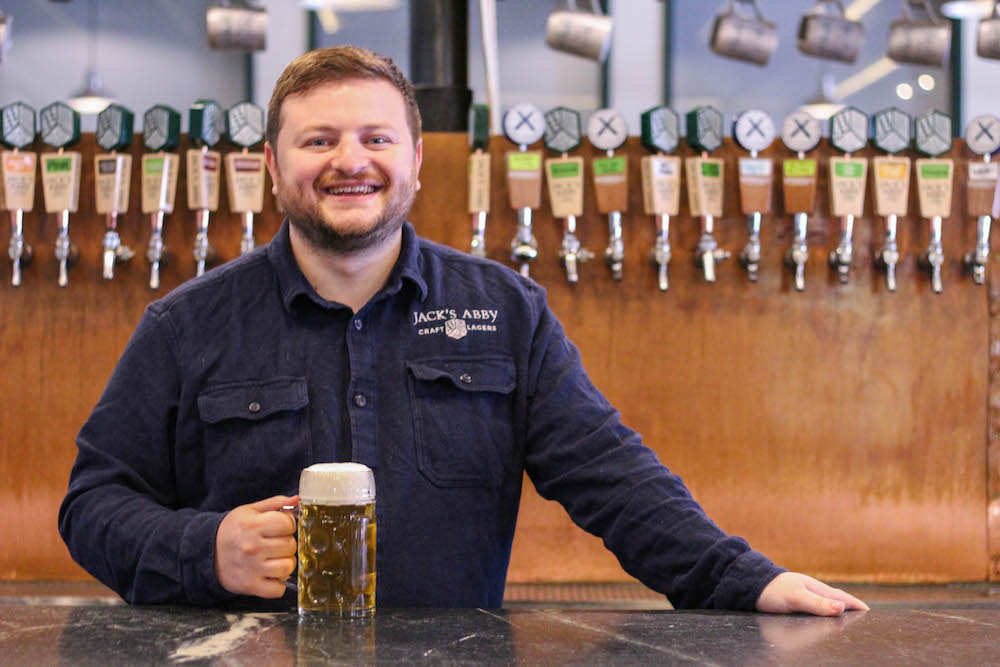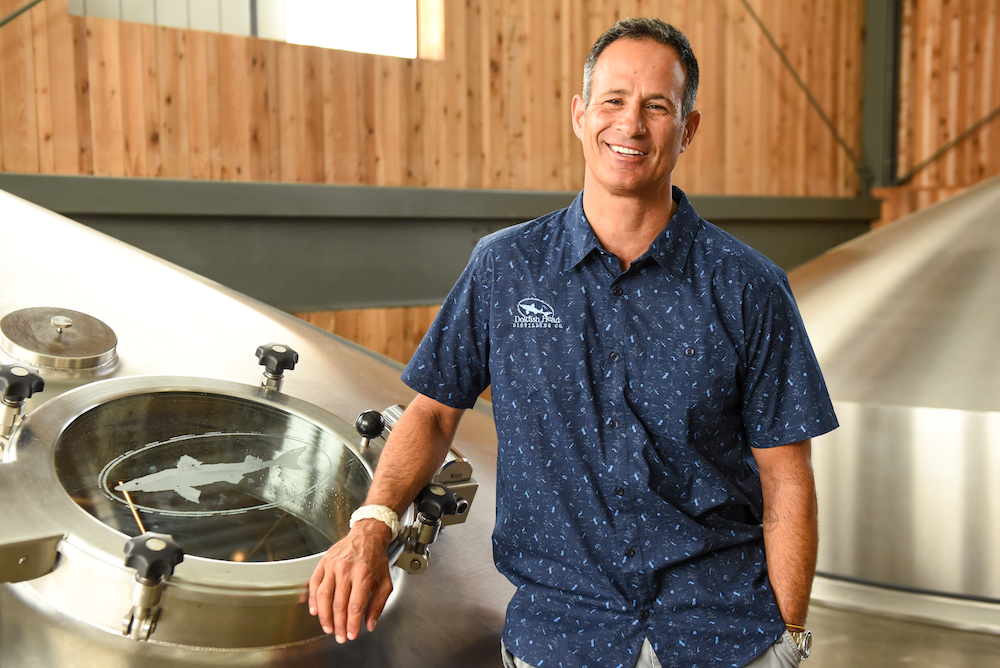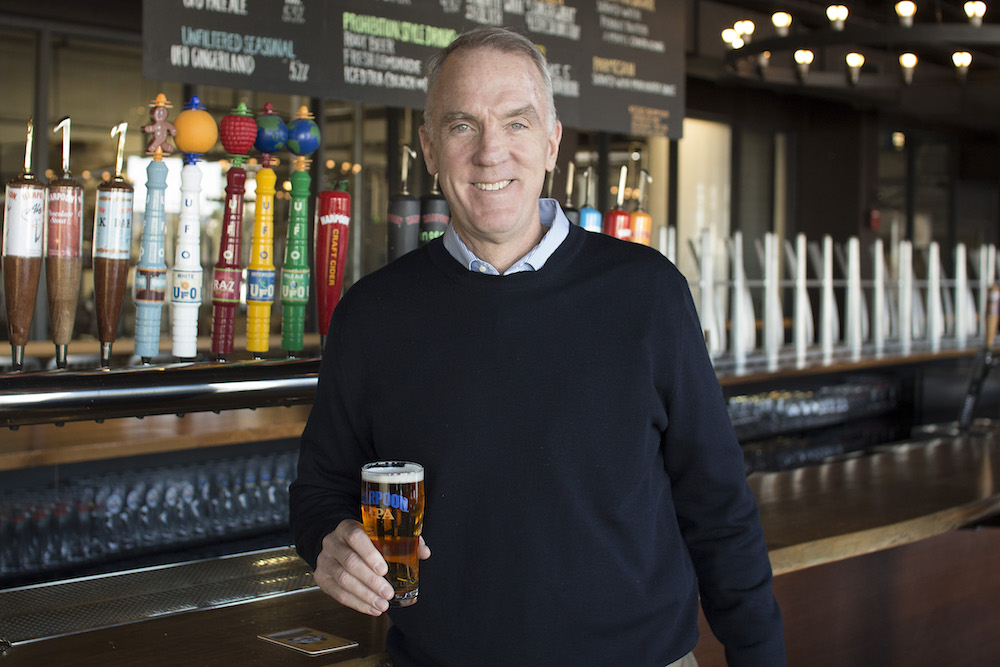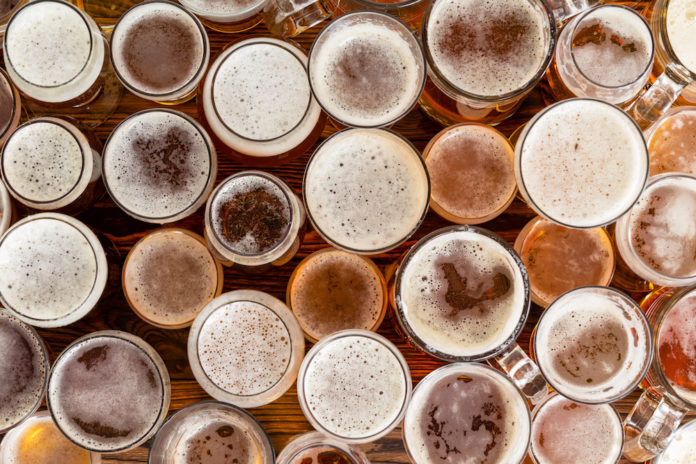Suffice to say, 2020 did not play out as originally planned for craft beer. Rather than a continued expansion of the taproom boom — which had breathed new life into the category while overall industry growth slowed — last year saw on-premise sales slammed by pandemic closures and restrictions. Naturally, this setback affects craft beer trends in 2021.
How so? It’s a mixed bag. Many trends in place before 2020 froze for lack of innovation during the difficult year of Covid. On the other hand, the pandemic altered consumer tastes and buying habits. Breweries adapted accordingly.
That’s why we see 2021 as a blend of what worked before the pandemic — and what works because of the pandemic. With that in mind, here are 10 craft trends in 2021.
Craft Beer Ecommerce
When Covid swept across the country in 2020, breweries had to change how they conducted business. They reimagined, often overnight, how consumers accessed craft beer. Often this was through ecommerce. With America still mired in the pandemic in 2021, we expect digital sales will continue rising.
“The biggest story for 2021 will be creating ways for access to market,” says Sam Hendler, co-founder of Jack’s Abby Craft Lagers. “Online, drive-through, curbside, beer gardens in parking lots, direct shipping.”
“You saw a lot of cool things in craft beer as people adapted to the new environment,” he adds. “2020 was a challenge, a real clusterf—. Nobody had a plan for a global pandemic.”

Agreeing with Hendler is Trace Smith, CEO of Next Glass, which owns Untappd, BeerAdvocate, Oznr and Hop Culture.
“Ecommerce has been hugely important,” he says. “Especially platforms that are more retail-specific, like Drizly and Oznr. Anything that helps brewers connect directly with their consumers — even the breweries’ own websites. In the first eight weeks of Covid-19, we saw decades worth of ecommerce adaptation in the industry.”
“Even if the ecommerce options only see a small number of users stick around after the pandemic, that that will still make a meaningful impact,” he adds. “But I do think we’re going to see the ecommerce bit stick around significantly.”
After the pandemic subsides, it’s unlikely that current ecommerce trends will suddenly reverse. Not when so many consumers have grown accustomed to this modern way of shopping.
But will state governments still allow these additional business avenues? Will special allowances permitted for the pandemic — curbside, DTC, cocktails-to-go — remain after the health crisis ends?
“It’s on us as brewers and retailers to utilize our rights and do these things safely,” Hendler says. “If we can prove over the period of a year-and-a-half, or longer, that there aren’t huge safety issues, then maybe we can make these things permanent.”
Low-ABV, Non-ABV Beers
The trend of lower- or no-ABV beers has been in the works for years. Not until recently, however, did it explode into the mainstream. How come? A vast improvement in quality. In years past, these beverages tasted watery, lacking full flavors of beer.
“AF (alcohol-free) beers didn’t always have a good rep,” says Jason Block, CEO of BrewDog USA. “As a brewery that wants to make people passionate about craft beer — with and without alcohol — we made a point to offer some of the best AF beers on the market to change that perspective. You can crack open a Nanny State or Punk AF and taste all the positive characteristics of a beer, but without the alcohol. We think that closing the gap between ‘regular’ and AF options is a big reason why AF beers are gaining popularity.”
Another question is: Who drinks these beers?
“The demographic for AF beers is wide,” Block says. “Drinkers are reaching for AF options because they are sick of hangovers, want to be mindful of their consumption or be more health-conscious — the list goes on.”
Dogfish Head Founder and CEO Sam Calagione agrees that the health-conscious aspect is key. After all, the “healthier for you” trend has permeated most food and beverage categories.
“Today’s consumer, especially those Millennial drinkers, are much more focused on wellness,” Calagione says. “They seek to lead active, well-balanced lifestyles that include both exercise and indulgence, and they are looking for products that fit into and reflect that lifestyle choice: low-calorie beers, non-alcoholic beers, hard seltzers and more.”
“That’s the same reason why, I think, we are going to see more, younger drinkers turning to non-alcoholic beers,” he adds. “Non-alcoholic craft beers can offer drinkers a different type of refreshment for occasions where alcoholic craft beers might not hit the spot, while allowing them to stay true to their lifestyle choices.”

The result was robust sales for these beers last year. Consumer interest should only accelerate in 2021.
“2020 was a breakout year for the NA (nonalcoholic) category, with multiple trends (sober curious, healthy living, doing more) converging to drive 38% growth overall, and triple-digit growth within craft NA’s,” says Brooklyn Brewery CEO Eric Ottaway. “2021 promises to be even bigger, as Covid woes continue to amplify those trends and more people become aware that no-alcohol doesn’t have to mean no-flavor and no fun.”
So how much more room for growth, exactly, remains for these beers?
“At still under 1% of the total beer market, NA beers have plenty of runway to growth,” says Ottaway. “In many European countries, NA beers are 5-10% of the total beer market, and are still growing faster than any other segment. The U.S. has a long way to go to catch up. Coming off the success of our Special Effects Hoppy Amber launch in 2020, Special Effects IPA is hitting shelves as we speak.”
Even the quality of more traditional, lower-ABV beers has improved.
“All of us have become better at delivering hop profiles at a lower-ABV,” says Matt Johnston, co-founder and CEO of Collective Arts Brewing. “Session IPAs used to be only a single note. Now, the body and depth is there.”
IPAs, IPAs, IPAs
No surprise here. IPAs will remain king of craft in 2021, led by the hazy style.
“There’s just something so approachable about the style, from the fruit juice aromas to the soft mouthfeel and lack of bitterness,” says Harpoon Brewery CEO and Co-founder Dan Kenary.
Harpoon’s latest New England IPA is Big League. Essentially, it’s a “double” of their hazy session pale ale, Rec. League, which has been Harpoon’s most successful new product since Harpoon IPA in ’93, according to the company. All of this indicates more good times ahead for hazies.
“Despite the crowding in the NEIPA category, there are still so many untapped drinkers in the space that we don’t expect things to slow down any time soon, even though we might be getting closer to the end of the road in diversification within the category,” Kenary says. “I imagine we’ll see things tighten a bit in terms of how many NEIPAs stores will be willing to carry, particularly with how vital freshness is for the style, but I bet the top-selling brands will continue to grow, while struggling brands will start to drop off.”
Craft Hard Seltzer
Hard seltzer has driven alcohol trends in recent years, so naturally many craft brewers have hopped aboard. In 2021, expect more producers to put out craft takes on this uber-popular beverage. These small-batch seltzers differentiate from macro counterparts by offering more character in the form of flavor, color, higher-ABV, unusual recipes or all of the above.
“A number of craft brewers have had good success in the category, albeit at much smaller volumes, but it’s all relative of course,” says Ottaway of Brooklyn. “What are crumbs to the big brands are meaningful volumes to craft brewers, and with demand still outstripping supply, there is room for more players.”

Brooklyn will launch a variety 12-pack of craft hard seltzer in spring 2021. Breweries across the country will follow this year, or have already done so, because of how well hard seltzer plugs into contemporary consumer trends.
“Hard seltzer drinkers care about ingredients and are attracted by the category’s better-for-you positioning,” says Kenary of Harpoon. “This bodes well for craft breweries who can launch hard seltzers that offer a meaningful point of differentiation. Our own hard seltzer, Arctic Chill — which is made with Polar Seltzer — has quickly become the best-selling regional brand in the category in New England.”
But with all these new craft seltzers coming onto market — plus gargantuan leading brands like White Claw and Truly — are retail shelves about to become oversaturated?
The industry does not believe so.
“I don’t think that craft hard seltzers have reached the mainstream craft beer drinker yet,” says Smith of Next Glass. “I think that most brewers will look at hard seltzer as something else to offer consumers who come into their taprooms. Like how more brewers got into kombucha, or distilling.”
“The lines are going to continue to blur between what hardcore enthusiasts consider craft beer versus the other categories,” he adds. “Brewers will realize it’s important to swerve with the trends.”
This sentiment is echoed by Mike Stevens, co-founder of Founders Brewing.
“We have a new generation of drinkers and are not at all just about craft beer,” he says. “We need to be open-minded to innovation and styles as we look into the next generation of consumer for the next 10-to-20 years.”
“The world of seltzers and RTDs plus into different channels,” Stevens adds. “We’re going to have to understand the shift in consumers who look at beer alternatives across the board. The good news is that craft is here to stay. But other innovations are going to have to flank the category.”
And the numbers speak for themselves. To wit: White Claw reported a staggering 275% sales increase in 2020.

“Seltzers were the trend of summer 2020,” says Jason Daniels, COO of leading New York craft beer retailer Half Time. “At one point, we were moving more White Claw than Coors Light.”
The Aluminum Can Shortage
As though the 2020 weren’t difficult enough, craft beer also contended with a national aluminum shortage.
This scarcity in packaging had a number of causes, including Covid roiling production and distribution in the aluminum industry.
Also, “We’ve recently seen everybody switch to 16-oz. cans, and variety packs with 16-to-36 cans,” observes Daniels. “Everybody made this switch to cans from glass.”
Including the spike in hard seltzers and canned RTDs, which further ate into the can supply. Occurring all at once, this caught aluminum producers off guard.
The resulting shortage affected “70% of products in the store, besides imports,” says Daniels. (Half Time primarily sells beer.) “I don’t know where it ends,” he adds. “It depends on production and distribution capabilities. I think we might see some better aluminum numbers in summer 2021, but who knows.”
Most brewers and industry professionals agree. Nobody knows when the aluminum shortage will end. Predictions shifted as 2020 wore on. Initial forecasts had Q1 2021 as when beer cans might become more readily available. Then that prediction bled into Q2, then Q3 — and now most people cannot pinpoint an exact date.
“Maybe by the end of 2021?” says Stevens of Founders. “Manufacturers cannot react fast enough to satisfy the huge demand. It’s literally a two-year process to accommodate for that new volume. It’s going to take time to catch up.”
One mitigating factor may be consumers returning to bars and restaurants as the health crisis winds down. The return to beer on tap, and cocktails by the glass, should alleviate the strain on aluminum.
“Covid came in and wiped out a huge section of our business in draft beer, so naturally everybody switched to canning for off-premise,” says Stevens. “Once the Covid problem goes away, the pressure will also go off of retail. We’re all trying to balance this: building out aluminum capacity, but not enough to satisfy the Covid problem as though that problem were permanent. It’s going to take a year or two to flush through this process and see where the dust settles.”
A Focus on Brand Building
Can some brewers see the future? Leading executives like Stevens of Founders and Calagione of DogFish Head have hammered for years now the importance of brand building. By this we mean focusing the majority of your time and finances on a small handful of flagship beers, rather than spreading too thin through over-innovation.
While nobody could have foreseen the scope of Covid-19, producers that followed the advice of Stevens and Calagione were better prepared for the reshaped economics of the pandemic.
“Brand building is pretty much the name of the game right now,” says Hendler of Jack’s Abby.
Particularly with the rise of craft beer ecommerce. Merchandising at retail is relatively simple. But online, your beer is one of many packed onto a beverage alcohol store’s webpage. And there’s no helpful employee in this digital aisle to point out the best brews.
“When people Google beer, brewers are really sharing the spotlight,” Hendler says. “If you’re not top of mind, people won’t think of you.”

This is why so many brewers have recently doubled down on leading brands: All Day IPA, SeaQuench Ale or Sierra Nevada Pale Ale.
“We’re putting more money than ever before into our core packages,” says Stevens of Founders. “We’re bound to be in a bit of a bruised economy for the next few years. Consumers will look for value and quality together.”
Without question, the pandemic has changed how consumers shop.
“During the pandemic and its subsequent pantry-loading moments, we have definitely seen more consumers gravitating toward brands they know and trust and love,” says Calagione.
Confirming this behavior is Daniels at Half Time.
“2020 was about consumers returning to core brands,” he says. “Customers wanted to come into our stores and grab what they needed, and not dilly dally while searching for beer ratings on their phones.”
Breweries that performed best during the pandemic had spent more time and finances on brand building: the likes of Dogfish Head, Sierra Nevada, Sam Adams, Stone, Founders and Jack’s Abby.
“I think that as long as we’re in the pandemic, all established brands have prominence,” says Hendler. “I think craft loses something in that. I hope the category doesn’t completely turn into that. A big part of craft beer is trying new things, finding that small brewery that makes a beer drinker fall absolutely in love.”
High-ABV Beers Return
An unexpected trend from 2020 was a comeback by high-gravity brews. (This also happened last year in whiskey.) Booziers stouts, barleywines, Belgians and imperial IPAs had been out of style for years, as preference tilted towards sessionable. But then the pandemic spurred a “treat yourself” mindset that had consumers cracking open bottles of something stronger.
“Higher-ABV has become an affordable luxury,” says Johnston of Collective Arts, which offers an array of well-regarded stouts. “Our smaller releases — the barrel-aged stouts and doubles and triples — there’s more excitement than ever for those. We’re all experiencing this pandemic, and treating yourself with one of these beers is something that we can all look forward to.”
Rather than 750-ml. “bombers” that boozy beers once came in, many brewers now put high-ABV releases in smaller packages — 16-oz. cans, or 375-ml. bottles. This better reflects consumer trends.
“We’re phasing into a consumer generation that wants to drink less,” says Stevens of Founders, one of the pioneers of heavy beers. “That allows for higher-ABVs as well. They’ll open a bottle of barleywine or stout, and just drink that for the night — like drinking one glass of wine.”
“Drinking is more measured now,” he adds. “The newer generation prefers less intake, but still enjoys the higher ABVs with fuller flavors.”
The “treat yourself” mindset was apparent at Half Time. “I saw a lot of Sam Adams Utopias move out the door in 2020,” says Daniels, “even older vintages.”
With the pandemic lingering into 2021, we predict more people will pop open heavier beers while settling into another evening at home. And regardless of Covid, these boozy brews will always enjoy a solid niche following.
“I do think the cult of high-ABV beers will stay vibrant,” says Calagione of Dogfish Head. “I know we get a lot of social engagement from people enjoying or looking for our 120 Minute IPA and World Wide Stout – both of which are over 15% ABV.”
Sour Beers Stay Popular
Speaking of growing niches, sour beers will prove popular again in 2021.
This growing style is another holdover from 2019. While attending beer fests two years back (remember beer fests?), you would have seen each brewery pour a hazy IPA, a heavier IPA and a fruited sour. Do you recall which of those three taps drew the longest line?
Almost always, the sours.

“Niche spots like sours are becoming more and more important because the newer consumer is looking for something different,” says Stevens of Founders.
Agreeing with him is Johnston of Collective Arts. “For us, that’s where a lot of demand is,” he says. “It’s a smaller category, but has high-scale growth. There’s so much creativity possible.”
“It used to be more of a niche group,” Johnston adds. “Not anymore. The demo for sours has pushed pretty wide. The softer sours, especially.”
That’s the key point. Sours have grown in recent years because they cast a large net in terms of interested drinkers.
“I think fruited sours will continue to be a strong and robust category,” says Calagione of Dogfish Head. “Fruited sours often have the ability to transcend their denoted category and appeal a much larger variety of drinkers. For example, our session sour SeaQuench Ale was the best-selling sour beer in America in 2020. It’s an off-centered mash-up of a crisp Kolsch, sea-salted Gose and tart Berliner Weiss brewed in sequence with lime juice, black limes and sea salt. The resulting citrusy-tart union has captured the hearts of beer, wine and margarita drinkers alike.”Hendler
Now with canned RTDs trending immensely, the number of consumers looking for sweet and sour flavors will only grow in 2021.
Classic Styles Stick Around
While German lagers or Belgian tripels may never rule the category, the quality of European-style beers made in America has never been higher. And more consumers have caught on.
Partly this is newer craft drinkers progressing from approachable hazies to other beers. Then there’s the old-school crowd that never stopped loving lagers and European recipes. While this trend will unlikely blow up in 2021, it should remain a relevant (and profitable) niche.
“We wouldn’t be shocked if there’s more of a return to tradition from seasoned consumers — drinkers that were into big IPAs and Stouts for a while and now just want something simple and balanced,” says Kenary of Harpoon. “I’d love to see old English styles and casks make a comeback, but I think we’re still a long way away from that.”
And remember: a lot of consumers already like lagers.
“I’m obviously one of the biggest lager evangelists out there,” says Hendler of Jack’s Abby, which only makes lagers. (Their Springdale Beer Co. brand produces ales.) “The craft beer world talks about returning to lager, but everybody else was already there. Bud Light, those kind of beers, they’re lagers. Lager is by far the number one style in the world. People already really like drinking lager.”

More Challenges, But Craft Beer Survives
When Covid-19 exploded in America and the country shut down, initial forecasts for craft were grim. Predictions had as many as half of U.S. breweries closing in 2020.
Mercifully, 2020 has come and gone. And far more than 50% of breweries still operate nationwide. But there’s no denying the damage done by Covid — and how much of a threat the pandemic still poses.
“It’s been very tough. We lost 35% of our business overnight when on-premise shut down,” says Kenary of Harpoon. “We’re optimistic that we’ll have wide distribution of the vaccines at some point soon, but we’re not betting on it. Until that day comes, on-premise business will only be a fraction of what it once was. Bars, restaurants and venues really are the lifeblood for so many craft breweries, and it’s incredibly difficult to see how this pandemic has impacted them.”
“There’s no way to predict just how tough things will continue to be in the upcoming months, but we have been impressed and not all that surprised that the number of craft brewery closings has been much smaller — so far — than feared,” Kenary adds. “We do have real concerns though that the first quarter of 2021 could be particularly challenging and lead to more losses.”
The view of a rocky road for recovery is shared by many in the industry.
“The saving grace has been the off-premise, which saw big growth from people staying and drinking at home, but even there, can shortages have really held back many craft brewers’ ability to supply this channel,” says Ottaway of Brooklyn. “Amazingly, relatively few craft brewers have succumbed so far, but many are running on fumes, and 2021 promises to be another tough year.”
Even during non-pandemic years, January through March tends to be the toughest time for breweries. Businesses nationwide hope consumers will not forget to support local during this early, trying stretch of 2021.
“I hope that the consumer realizes that the current environment poses an existential threat to local beers and supports their local breweries by voting with their wallet,” says Hendler of Jack’s Abby. “And I hope that retail stores take the time to vote by figuring out which breweries they want to feature while chatting up the customer through their social and websites.”
In Covid-19, craft beer faces its greatest challenge in decades. Not since the late ‘90s/early ‘00s — when an economic bubble burst because of industry overextension and declining quality — have brewers fought against such an existential threat.
How will the industry survive? As it always has: through adaptation.
“I think we can all agree — the pandemic has taken a toll on all businesses in the hospitality industry, craft breweries included,” says Calagione of Dogfish Head. “It has caused many breweries to have to be more creative and flexible, continually adapting their business models to keep their doors open. But, craft brewers are hardworking, innovative and resilient individuals. No one can tell exactly what the future will hold, but if anyone can persist through this pandemic, it’s craft brewers.”
Kyle Swartz is editor of Beverage Dynamics magazine. Reach him at kswartz@epgmediallc.com or on Twitter @kswartzz. Read his recent piece Q&A: The State of Beer in 2020-21, with NBWA Chairman Brian Gelner.







[…] into the “healthier for you” trend, Grey Goose Essences are 30% ABV, and contain no artificial ingredients, sugar or carbs. They are […]
[…] the category trends, non-alcoholic beer producer Partake Brewing has announced a second distribution expansion to […]
[…] Fuentes: Escarpment LaboratoriesLinchpinBeverage Dynamics […]
Most of these trends are idiotic. As a brewer, I would never do an NA “beer” or a hard seltzer, because to do so would just be pandering to fools, and is disrespectful to the craft of brewing in general. It’s bad enough that I have to do IPAs all the time, it’s a boring style, but at least it’s beer.
One thing I’ve learned from working at a brewery that doesn’t just follow trends, and flat out refuses to follow some trends, is that the customer, in the brewing industry, is by no means always right. The customer is usually an idiot who needs to be told what he likes. And as brewers, it’s our job to help him like actual good beers, not just IPAs and similar trendy nonsense.
Wow, arrogant much?
[…] Credit: https://beveragedynamics.com/2021/01/19/craft-beer-trends-in-2021/ […]
[…] are notorious for experimenting with recipes and brewing techniques in an attempt to develop new styles of beers. While many brewers have made beers using lager ingredients and ale yeast with good […]
[…] there’s any question about which material reigns supreme in the world of craft beer packaging, let’s dispel it: glass and aluminum are the materials of choice. These materials are relatively […]